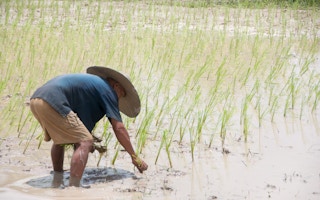Between record-breaking heatwaves across the northern hemisphere last summer and the close of the UN climate talks in Poland, climate change is increasingly occupying the public consciousness, with many now wanting it prioritised as a top political issue.
To continue reading, subscribe to Eco‑Business.
There's something for everyone. We offer a range of subscription plans.
- Access our stories and receive our Insights Weekly newsletter with the free EB Member plan.
- Unlock unlimited access to our content and archive with EB Circle.
- Publish your content with EB Premium.
Our attention naturally turns to the major contributors to global warming. For most of us, transport emissions, electricity production, and increasingly livestock production immediately spring to mind. But there is a lesser known player that should be added to this line-up: rice production.
Why? Because rice production is one of the leading man-made contributors of methane, contributing 10 per cent of total methane emissions, as vegetation rots in water-soaked paddy fields. That is nearly as much as from landfills (11 per cent) and well ahead of coal mining (6 per cent). Put another way, rice production—all 500 million metric tonnes a year—emits as much carbon dioxide through methane emissions as the whole of Germany. Furthermore, methane is 34 times more potent than carbon dioxide as a greenhouse gas.
This is an uncomfortable reality given that rice is the daily staple for over half of humanity, and the financial backbone for millions of rice-farming families in Asia—the world’s rice bowl. For many in the region, ‘rice is life’, as the Thai saying goes. So entangled is rice in the culture that if you walk down a street in Thailand, you will likely be greeted with “Kin khao reu yang” or “Have you eaten rice yet?”, which incidentally, if you respond “no” to, doubles up as accepting an invitation to dinner.
So there is a paradox where rice is crucial to food security yet cultivated at such large volumes in a way that contributes to the global climate crisis—we need to tip the balance in favour of people and planet.
How? Not by stopping the growing or consumption rice, but rather making its production sustainable, and reducing emissions without hurting the farmers and communities who depend on it for income and sustenance.
“
Feeding the world and saving the planet have to become mutual goals if we are to meet the demands of a billion extra people by 2030, while keeping global warming below the 1.5°C critical risk threshold.
As one of the world’s largest rice traders, Olam has been working with like-minded partners to re-imagine the sustainable rice supply chain. We are a founding member of the first voluntary sustainable standard for rice—the Sustainable Rice Platform (SRP), co-convened by UN Environment and the International Rice Research Institute.
At the heart of the SRP framework is implementing effective, easily applicable climate-smart practices—after all, rice is grown under many disparate farming systems. Done right, SRP methods can reduce methane emissions by up to 70 per cent and improve farmer livelihoods at the same time.
Together with the Thai Rice Department and German development agency, Deutsche Gesellschaft für Internationale Zusammenarbeit (GIZ), we put the SRP standard to the test in 2015, piloting the world’s first fully verified sustainable rice programme with farmers in Thailand’s Ubon Ratchathani.
For these farmers, implementing SRP meant a combination of simple agronomy practices including land levelling, better inputs—such as better quality seeds and tools—proper soil management and fertiliser application, and biomass removal. Together with our partners, we provided the farmers with training and advice on implementing the agronomic practices, and guaranteed a market for the rice they produced.
Fast forward three years, and 1,500 farmers are receiving more income from higher yields, better cost management of agri-inputs, and a quality crop that carries a lighter environmental footprint. One such farmer is Kriengkrai Chanpeng from the Warin Chamrap district, who has seen yields improve 55 per cent from his harvest this year compared to last. In the neighbouring Khok Sawang district, Duangchan Witchalin doubled her profit on this year’s grains compared to last.
Now that we have a definition and proven model for sustainable rice in SRP, we need to catalyse change on a greater scale. With our partners, Olam aims to reach 150,000 farmers by 2023 in Asia and Africa, but the rice produced will need take-up. This is where retailers, namely major supermarket chains, hold the power. By using SRP as a procurement standard and engaging with stakeholders like banks and insurers to incentivise farmers who produce rice sustainably, they can lead this change and in turn, help meet this growing demand for sustainable rice.
Feeding the world and saving the planet have to become mutual goals if we are to meet the demands of a billion extra people by 2030, while keeping global warming below the 1.5°C critical risk threshold. Opening up the market for sustainable rice would be a major step towards achieving this.
Paul Nicholson is the Vice President of Rice Research and Sustainability at Olam International. This article was written exclusively for Eco-Business.


















